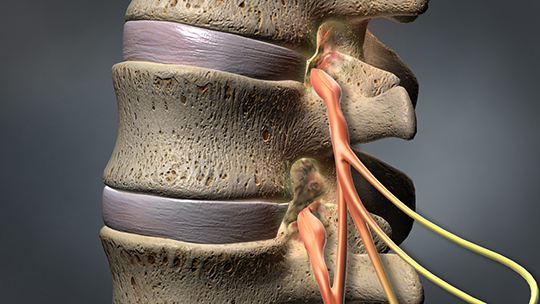What is lumbar spinal stenosis?
As we grow older, our spine changes, often leading to the degeneration of the vertebrae, or the bones of the spine.
Lumbar spinal stenosis is when the spinal column narrows and puts pressure on the nerves leaving the spine.
Compression in the spine, caused by bone spurs and disc damage, can lead to scoliosis and arthritis. This condition typically worsens with age.
We have 3 convenient locations throughout Southeastern Wisconsin.
What are causes of lumbar spinal stenosis?
Lumbar spinal stenosis symptoms are usually related to the inability to walk a distance or stand for any prolonged period of time. The medical term for this weakness in the legs and difficulty walking is neurogenic claudication.
For most people, this is a slowly progressive symptom that develops over months or years. Back pain can feel stronger than leg pain. It can also be overshadowed by the intense pain in the legs.Your doctor may recommend an epidural steroid injection (ESI) to help manage your symptoms.
This involves injecting a mix of steroids and anesthetic around the spinal nerves, depending on how severe your case is.Your doctor may recommend an epidural steroid injection (ESI) to help manage your symptoms. This involves injecting a mix of steroids and anesthetic around the spinal nerves, depending on how severe your case is.

How is spinal stenosis diagnosed?
Doctors can diagnose lumbar spinal stenosis in a few ways. A common method is performing an MRI or a CAT scan. Medical professionals may also use x-rays, myelograms, or bone scans. The results of these tests help determine the best treatment options.
Dr. Ahuja and staff perform radiological procedures at The Brain and Spine Imaging Center, our state-of-the-art imaging facility in Franklin, Wisconsin.
Is surgery necessary for lumbar spinal stenosis?
In most cases of lumbar spinal stenosis, surgery is necessary to relieve pressure from the spinal nerves. This procedure, known as a decompressive lumbar laminectomy, involves the surgical removal of a portion of the bony structure called the lamina to create more room for the nerves. This surgery typically has a quick effect on the ability to walk and stand.
Patients usually return home from the hospital in 2-3 days, with a recovery period of about 4 weeks.
What are non-surgical treatment options for lumbar spinal stenosis?
If you notice your health deteriorating, seeking diagnosis and medical care should be your next step. Doctors may suggest non-surgical treatments for lumbar spinal stenosis. These treatments can include anti-inflammatory drugs, nerve medications, and mild pain relievers.
Although these medications may alleviate some symptoms, they will not halt the progression of the condition. Exercises and various physical therapies can also provide positive outcomes for pain relief and management.
Depending on the severity of your case, your physician might suggest an epidural steroid injection (ESI), where a combination of steroids and an anesthetic is injected into the area around the spinal nerves to control symptoms.

